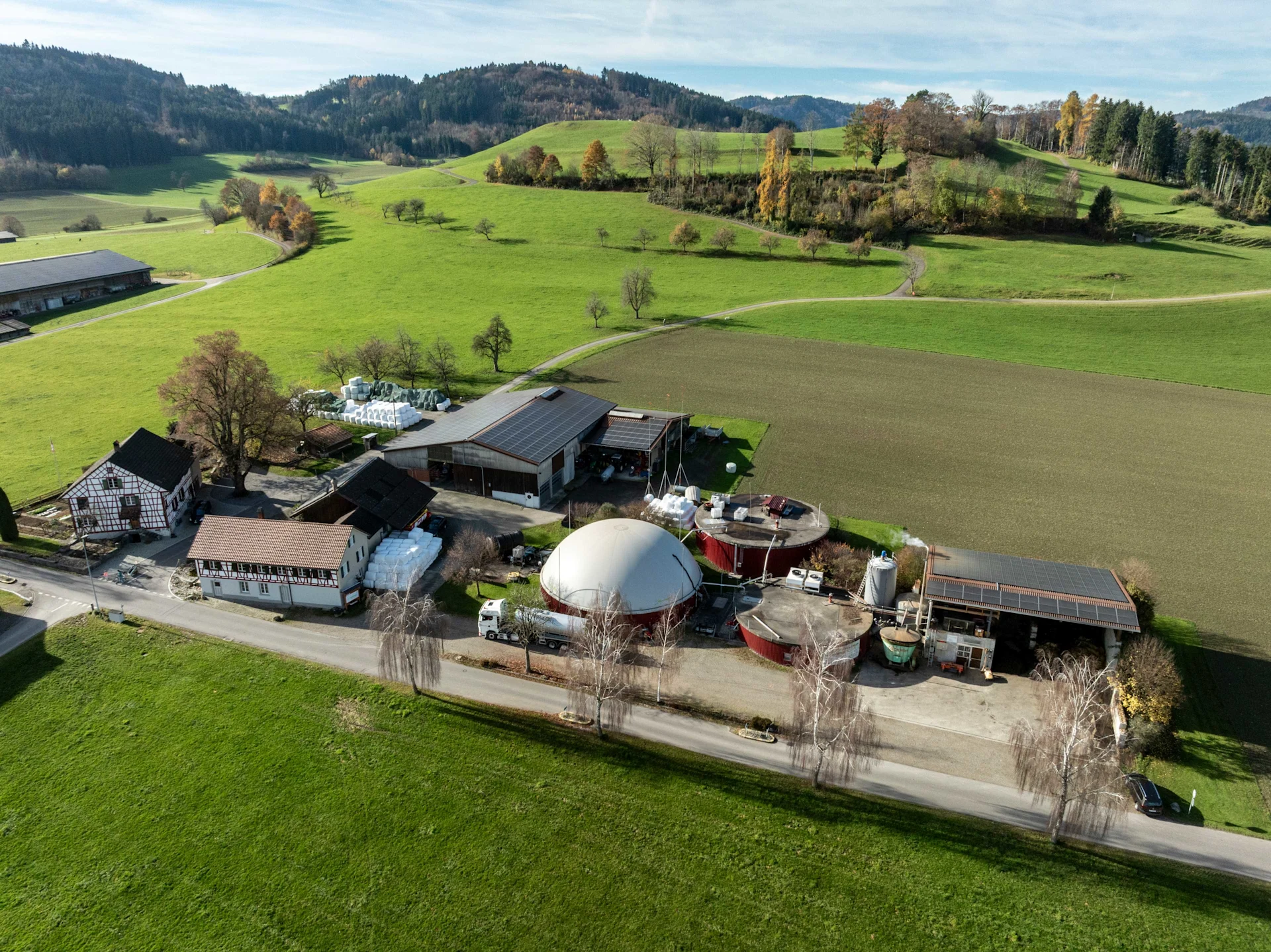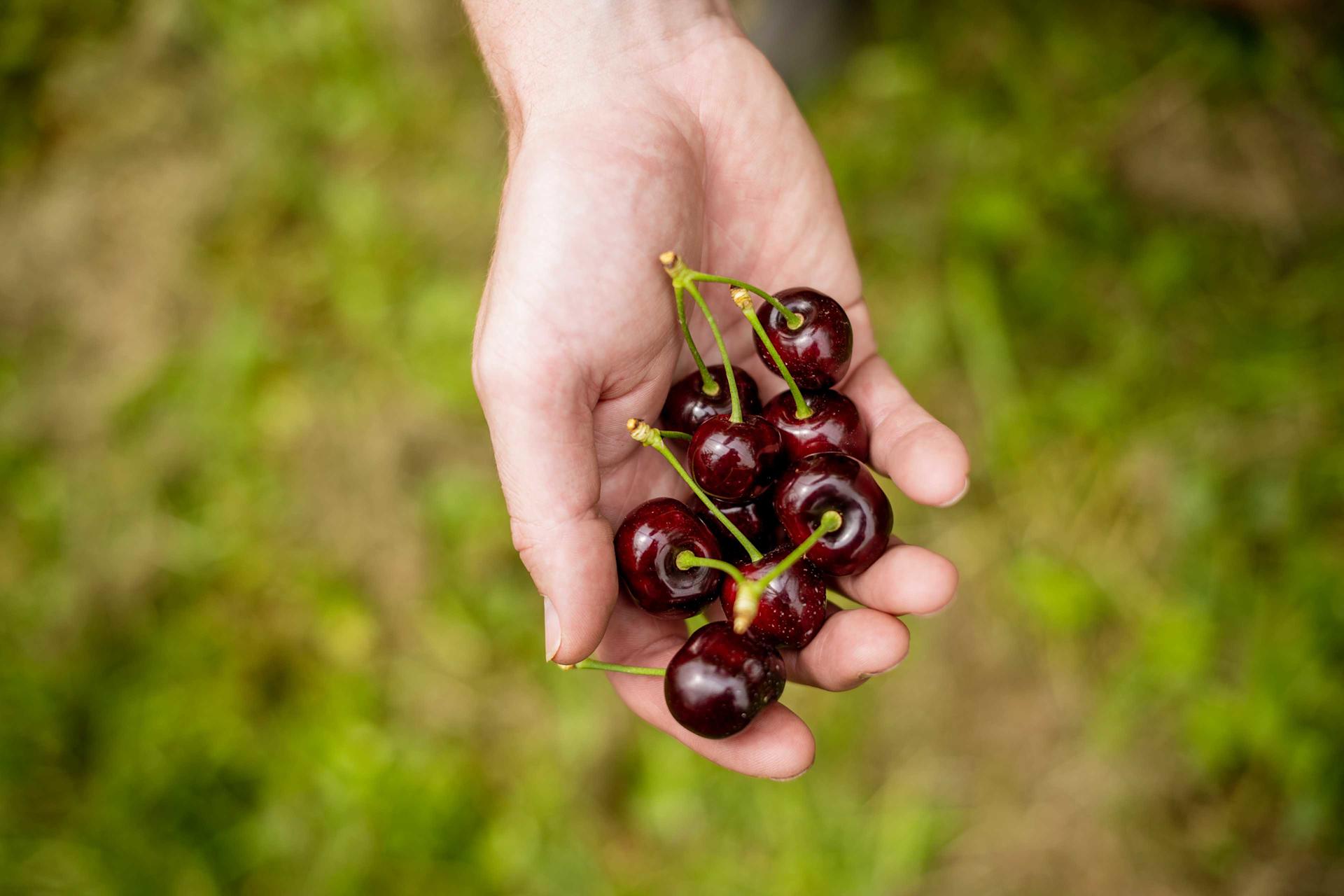
Sustainability
How is biogas produced?
Generated through the fermentation of liquid manure and other residual waste, can then be used for electricity.
navigation

Sustainability
It's cherry season! Now they're even more sustainable. Why is that? We visited David Hofmann's cherry orchard in the Bernese Seeland.
His farmhouse in Sutz lies on the shores of Lake Biel. Behind the house are about 600 cherry trees lined up in rows, all covered by fine black netting. 2025 promises to be a good year for cherries: the spring was neither too dry nor too wet, and sufficient sunshine enabled the fruit to ripen in time for harvesting. Farmer David Hofmann slips through the curtain-like opening. The air inside the netting is heavy. Not a breath of wind can be felt. Rainproof plastic sheeting above the trees also protects the cherries against heavy rain and hail. That's a wise move, but causes heat to build up under the plastic. "It's 10°C warmer in here than outside the netting. On hot days, the temperature has reached up to 45°C," Hofmann reveals. The 37-year-old took over his parents' mid-sized fruit business seven years ago. The farm includes another cherry orchard with a further 1400 trees, as well as 1000 plum trees and 10,000 apple trees.
The netting keeps voracious birds away from the fruit and is so tightly meshed that even the dreaded vinegar fly, whose larvae cause fruit to perish, has no chance of getting inside. "The netting means I don't have to spray the cherries so often," Hofmann explains. He has another trick up his sleeve to tackle a different pest. Thin orange strips hang in the trees every few metres. These strips emit a scent that confuses male summer fruit tortrix to such an extent that they can't find females, preventing their caterpillars eating through the cherry leaves. This is yet another way in which Hofmann reduces the use of pesticides. Unfortunately, it doesn't cut his overall costs and labour.
These are just two examples from a list of about 100 measures that are helping to make the growing of cherries and plums more sustainable. Since this year, all Swiss cherry and plum producers that supply retailers like Migros have been able to register with the nationwide Fruit Sustainability programme. This includes a set of specific measures. Participating enterprises pledge to reach a specific number of targets as part of the programme, thereby further improving the sustainability of cherry and plum cultivation.
David Hofmann's business took part in the pilot programme last year. He also helped to define the list of measures. "We wanted as many cherry farms as possible to sign up for the programme. That's why the requirements had to be realistic," Hofmann explains. Farmers must meet 30 of the criteria set out in the list during the first year, 35 in the second and 40 thereafter. This staggered implementation is intended to give producers time if they have to purchase new equipment.
Hofmann was fortunate. He has already replaced the diesel-powered platform used to reach the topmost cherries with an electric one. The cost: CHF 80,000. He can also tick off measures on the checklist because he has replaced the old oil-fired heating system in his house with a wood-burning one. Hofmann is now also creating wild flower meadows on some of his arable land to provide habitats for insects, in turn improving biodiversity. For eight years, he will grow nothing else on this land.
Suddenly Lio, a little livewire, appears – running up to us wearing colourful rubber boots on his tiny feet. The three-year-old climbs up a ladder, skilfully grabs the darkest cherry and pops it in his mouth. Then he demonstrates how to spit the stone out properly. Spotting his mum with his almost one-year-old sister Mayla in her arms, Lio picks a few more cherries from the tree and descends the ladder backwards. He holds out a cherry to his little sister, having already cut it in half with his little teeth and removed the stone. She eats the sweet fruit with obvious pleasure.
This fruit is the result of a whole year's work.
David Hofmann looks at his wife Leona and their two children. "From my perspective, sustainability also means that we get a fair price for our healthy fruit. And not just a price that's enough to survive on, but that allows us to make investments that have a long-term effect and last into the next generation." Thanks to the new sustainability programme, Hofmann now receives an additional CHF 0.25 per kilo of his sweet cherries and CHF 0.20 more per kilo of sweet plums.
Hofmann already has ideas for how he could run his farm even more sustainably. He wants to soon replace artificial fertiliser with compost from a mushroom producer in the region. This is rich in humus, which would provide Hofmann's soil with plenty of nutrients.
The busiest time of year for the Hofmanns is right now when Swiss people are about to leave on their summer holidays. For four to five weeks, between 15 and 20 people pick the cherries by hand every day. They gather about 20 tonnes in total. His plums are then harvested in August and the apples in September and October. But this doesn't mean there's nothing to do for the rest of the year. In winter, Hofmann is kept busy daily for three months pruning his trees. "This fruit is the result of a whole year's work," he says, pointing to the dark red cherries. He tousles Lio's hair. The boy laughs mischievously, his lips stained a deep blue from the cherry juice, as he pops another plump cherry into his mouth.
Sustainability is part of our culture and we still have plenty more on our agenda. Learn more about it in our Stories!